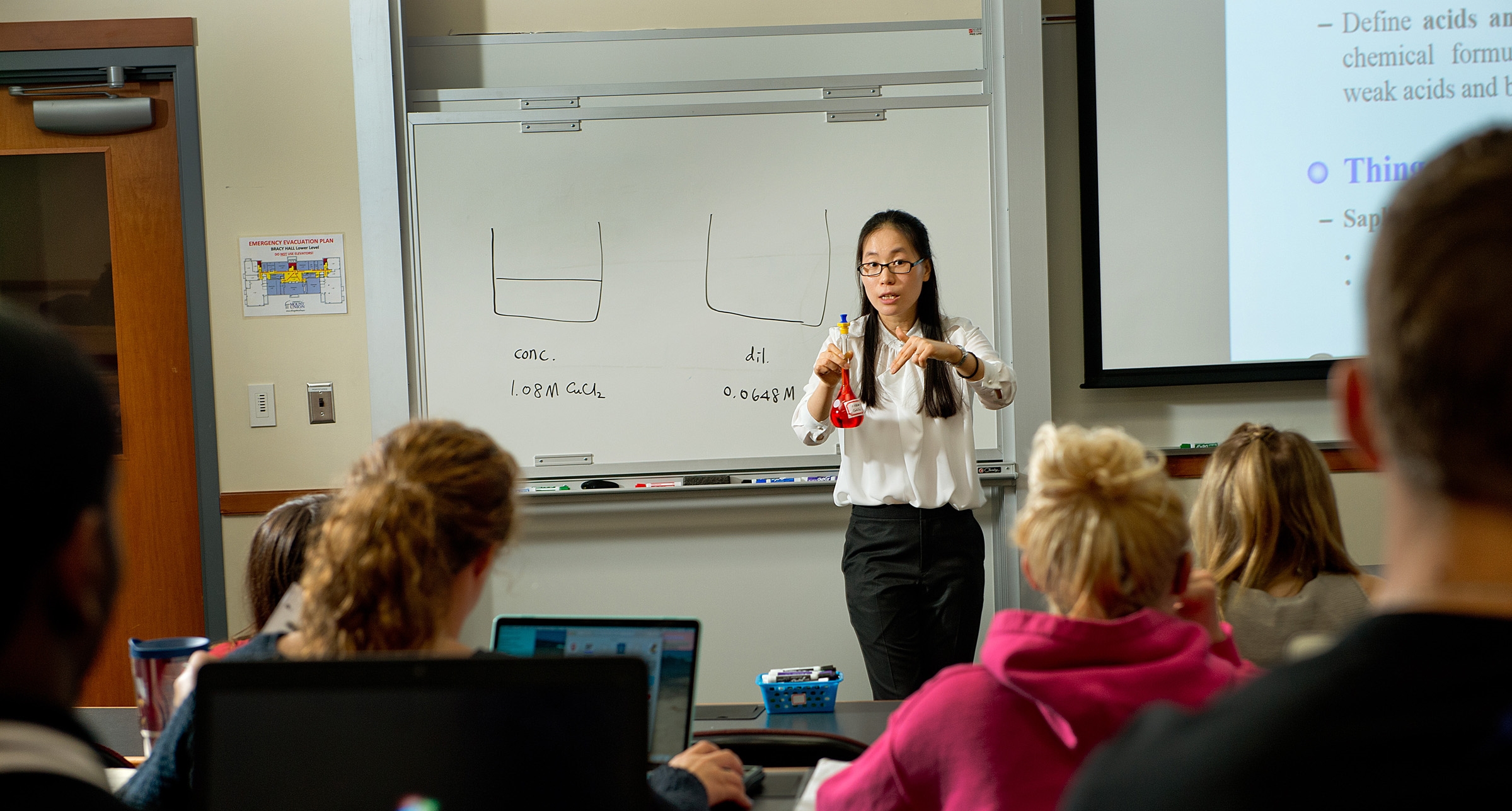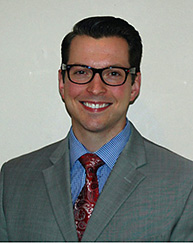Bachelor of Science in Biochemistry Degree
Contribute to high-impact research and lay the groundwork for a remarkable career through our Bachelor of Science (B.S.) in biochemistry degree program. Our graduates go on to excel in areas like biotechnology, molecular biology, pharmacology, and other health and medical sciences.
Mount Union’s B.S. in biochemistry degree program is approved by the American Chemical Society (ACS) Committee.
Foundation in Experiential Learning
Interrogate the composition of living things. Analyze the chemical combinations and reactions of life processes. Expand your understanding of life in its most essential forms.
Through real-world research and lab-based classroom learning, you’ll become fluent in essential topics like organic and inorganic chemistry, analytical chemistry, biochemistry, metabolism, nutrition, pharmacology, physics and calculus.
The 120-credit biochemistry major involves 61 major-specific credits in small class sizes and additional expertise from our wide-reaching integrative core, extracurricular internship opportunities, network of industry professionals, and a culminating senior research project.
Learn more about the Biochemistry Major
Accomplish meaningful research goals during your undergraduate degree and prepare for a world-opening career through Mount Union’s Bachelor of Science in biochemistry. Our top-notch laboratories, eager faculty collaborators and wide-reaching professional networks will equip you for success in this rapidly expanding, ever-evolving field.
-
Curriculum
Biochemistry CurriculumEngage in thorny questions and paradigm-shifting discoveries in Mount Union’s biochemistry degree. Here, you’ll examine the molecular basis of life processes in our society with a focus on applications in the life sciences. Find chemistry and biochemistry in our undergraduate catalog to learn more about what you’ll achieve in the biochemistry major.
Through in-depth study of biology and inorganic, analytical, organic, and physical chemistry, you will explore chemical substances, processes, and reactions that occur in living organisms. As you advance toward the BS in biochemistry, you will wrestle with more complex concepts in biochemistry, including metabolism, nutrition, pharmacology, gene expression and biotechnology.
You’ll apply your expertise as an undergraduate through internships, research projects, student organizations and other industry-leading experiential learning opportunities.
-
Experiential Learning and Student Organizations
Biochemistry Experiential LearningWhat can you do with a biochemistry major? You’ll get a pretty good idea at Mount Union through ample opportunities for real-world experience beyond the classroom. In the biochemistry degree program, you will practice your learning in labs, cooperate with others in student organizations, investigate your curiosity through leading-edge research and more.
Laboratory Experience
Right from your first year of your BS in biochemistry, you will consistently gain valuable laboratory experience in wet chemical analysis, characterization of the properties of various molecules, instrumentation, synthesis of molecules and development of techniques and skills. Later in the biochemistry degree, you’ll practice increasingly demanding techniques and more sophisticated instrumentation.
Our laboratory work is discovery-based, meaning you’ll learn-by-doing with hands-on practice, receive guidance for improving your skills and then apply your newfound expertise to an unknown system.
Hands-on Undergraduate Research
Grab hold of meaningful opportunities to advance your scholarly and professional interests through research projects. Mount Union’s unique undergraduate research program helps you to enhance your learning and broaden your academic prospects through faculty collaborations on topics like:
- Development of synthetic schemes to produce chemical compounds which mimic enzymes
- Study of diet and exercise as it relates to oxidative stress and Alzheimer’s disease
- Synthesis of novel inorganic compounds related to the scorpionate ligand family
- Computational studies of high-energy compounds
- Green chemistry synthetic schemes for the development of carbon-carbon bond formation reactions
- Development of sampling and analytical methods for the detection of pharmaceuticals in treated municipal waste water
- Laser spectroscopic detection of radical intermediate compounds present in photochemical smog and acid rain
- Investigation of the effectiveness of videos in classroom instruction
- Investigation of the usefulness of online homework for classroom instruction
Internships
Gain hands-on experience in workplaces and research facilities to enhance your employability post-graduation. Internships allow you to apply your classroom learning in dynamic, influential settings as you prepare for graduate school or your professional career.
You’ll network with experts and seek out opportunities related to the biochemistry major that align with your interests at companies like:
- State of Ohio Crime Lab
- Firestone
- Sherwin-Williams
Student Organizations
Collaborate with your peers, gain practice in the field, network with professionals and seize leadership opportunities through Mount Union’s biochemistry-related student organizations.
- American Chemical Society
- Alembroic Society
-
Careers
Biochemistry CareersCommit to your curiosities about life in all its forms. Biochemistry is an exciting, growing field, propelled forward by the Human Genome Project and more fresh insights into the living world. According to the Bureau of Labor Statistics, employment of biochemists and biophysicists is expected to increase faster than the average for all occupations, and median pay in this field is over $103,000 per year.
Mount Union’s major in biochemistry is structured to prepare you to fill this growing need in our society. Specifically tailored to application in the life sciences, the biochemistry degree will equip you to explore chemical substances, processes and reactions that occur in living organisms—skills that you will carry into exceptional career and graduate study opportunities.
Recent Employers- Nalco
- Smith Ambulance
- McGean-Rohco
- Amgen
- The Scripps Research
- Institute
- Steptoe and Johnson
- Sherwin Williams
Common Careers- Pharmaceuticals
- Biotechnology
- Genomics
- Proteomics
- Medicine
- Allied Health
- Physician Assistant Studies
- Physical Therapy
- Patent Law
Recent Graduate Schools
- Carnegie Mellon University
- Case Western Reserve University
- MIT
- University of North Carolina-Chapel Hill
- Penn State University
-
Facilities and Equipment
Facilities and EquipmentIn the Bracy Hall of Science, you’ll access and experiment with a wide variety of top-of-the-line instruments, computer resources, library books and journals. Prepare for your future as a thinker and researcher in hands-on Bachelor’s in Biochemistry lab courses, faculty collaborations and independent research projects.
Fourier Transform Infrared Spectrometer (FT-LR)
Different types of molecular bonds absorb infrared light differently. We can measure this absorption with an FT-IR and identify which types of bonds (and therefore which functional groups) are present in a sample. This helps us determine some of the chemical features of a given molecule.
Plate Readers
Plate readers enable us to measure the absorbance or fluorescence of many very small samples in a short period of time. In the biochemistry degree, we often use these instruments in biochemical studies where we need to determine the concentration of protein in a sample, monitor enzymatic reactions, and examine protein-DNA binding.
Gas Chromatograph (GC)
The gas chromatograph vaporizes samples and moves them through a column of tubing. The rate of migration of a given molecule through the column depends on its attraction to the column material, which causes the components of the sample to separate.
As the components exit the column, the GC detects their relative amounts. We can use this technique to determine the purity of a sample, how many components are in the sample, and some information about the chemical properties of the components.
Gas Chromatograph-Mass Spectrometer (GC-MS)
After the molecules have been separated by the GC, we use the GC-MS to analyze them with mass spectrometry, which precisely determines the molecular mass of the molecules present in the sample.
Mass spectrometry may also cause fragmentation of the molecules, which can give further insight into a given molecule’s structure. This technique can positively identify the molecules present in a sample and is often used in forensics, drug analysis, and disease identification.
High-Performance Liquid Chromatography (HPLC)
HPLC is similar to GC, except the sample travels through the column in a liquid solution instead of as a gas. We use HPLC to analyze the contents of samples such as pharmaceuticals and consumer products, and to monitor enzymatic reactions.
Atomic Absorption Spectrometer (AA)
If an atom becomes excited, it can emit light of specific wavelengths. The atomic absorption spectrometer excites a sample and measures the resulting atomic absorption spectrum. This spectrum acts like a fingerprint from which we can determine if a particular atom is present in the sample.
Ultraviolet-Visible Spectrophotometer (UV-VIS)
As a biochemistry major, you’ll use the UV-visible spectrophotometer to measure the degree to which a sample absorbs light in the ultraviolet and visible regions of the spectrum. This technique can be used to determine the concentration of a molecule in a sample or to give clues to the identity of the compounds present in a sample.
Nuclear Magnetic Resonance Spectrometer (NMR)
Our NMR spectrometer allows us to determine a great deal of information about the chemical structure of samples. NMR is a powerful technique that applies a strong magnetic field to a sample, causing the spins of the atomic nuclei to align.
Radio waves are then applied to the sample, causing some of the nuclei to become unaligned (flipped). The frequency of the radio wave required to flip a given nucleus depends on the chemical environment of the atom, and the spectrometer measures how the sample absorbs these radio waves.











